1. Introduction and vision
In March 2014, the National Statistician recommended that the census in 2021 should be predominantly online, making increased use of administrative data and surveys to both enhance the statistics from the 2021 Census and improve statistics between censuses. The government’s response to this recommendation was an ambition that “censuses after 2021 will be conducted using other sources of data”.
Decision-makers (central and local government, businesses, charities, community groups and citizens) increasingly need better local data on the size and characteristics of their population to build better services such as transport links, schools, hospitals and housing. They need to understand the changing dynamics of the population nationally and locally, so they can make the best decisions based on that evidence.
In 2021, we’ll continue to meet this through the census. However, as the pace of change is increasing, decision-makers need this information much more frequently than every 10 years. In particular, they need to understand the changing nature of our population and migration to and from the UK more regularly and locally.
This is why we have our ambitious programme of work to put administrative data at the heart of the system. By spring 2020, our population and migration statistics system will be based primarily on data that already exist around government, utilising our data-sharing powers through the Digital Economy Act 2017.
This programme does not stop at providing these population data. We’ve also been researching how to use data such as these to get an up-to-date picture of other important policy areas, for example:
commuting patterns to better inform transport policy
educational qualifications and employment to inform skills policy
income to inform equality and social mobility policy
We’ve described the work to meet the need for more frequent information as an Administrative Data Census. Until now, we’ve focused largely on the ability of administrative data and surveys to provide the information traditionally collected through questions on the decennial census. However, integrating data from a range of sources offers much wider potential to improve statistics on a variety of topics. These topics include:
fuel poverty
mental health
debt
crime
inequalities
ageing
migration
housing affordability and provision
This will result in better decision-making across government in line with UK Statistics Authority strategy – Better Statistics, Better Decisions (PDF, 1.4MB).
The assessment presented here uses the same criteria and scope as those used for 2016 (PDF, 751KB) and 2017 in terms of our ability to move towards an Administrative Data Census. We’ll be reviewing the structure of this assessment and the criteria in the coming year given the wider opportunities from integrating data.
Nôl i'r tabl cynnwys2. Assessment of progress over the past year – main points
This is our third assessment of our progress towards an Administrative Data Census. As with previous assessments, we summarise our current position and where we expect to be in 2023, when we’ll make a recommendation on the future of the census.
You can find further information on the evaluation criteria we’ve used in our previous assessments.
Figure 1 shows this year’s assessment alongside the previous assessments. This year we’ve also added a “next steps” column to note our priorities for taking the work forward.
This year we have:
developed a methodology for household size and household composition – this has improved our assessment for this topic from Red/Amber to Amber
worked with data owners to understand their data and specify requirements, primarily for income and migration datasets
published population estimates to Output Area level
published an assessment of two methods for producing coverage-adjusted population estimates
published a wider range of research into producing population characteristics, including new outputs on new mothers’ income, internal migration, household composition, ethnicity, small-area income distributions, commuting flows and labour market status
started research into producing international migration estimates with administrative data at the core
Figure 1: Current assessment of ONS’s ability to move to an Administrative Data Census
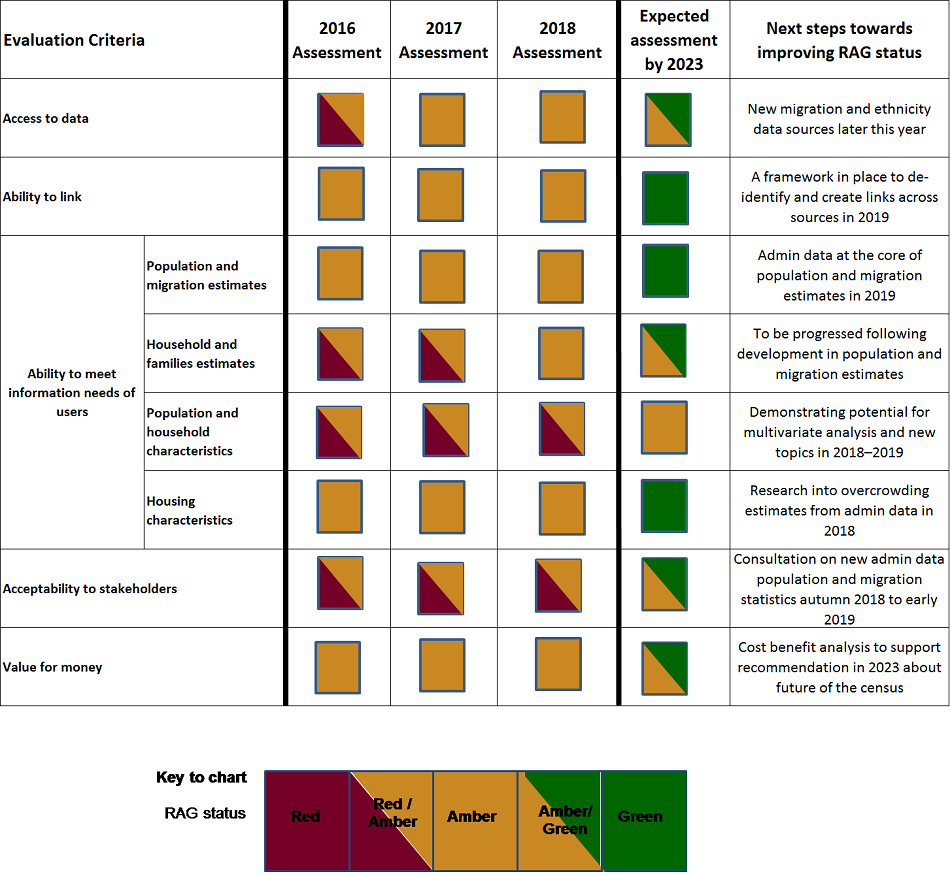
Source: Office for National Statistics
Notes:
- To view a larger version of Figure 1, please download the png.
Download this image Figure 1: Current assessment of ONS’s ability to move to an Administrative Data Census
.png (201.6 kB)4. Progress updates on each of the evaluation criteria
4.1 Access to data
This evaluation criterion is currently assessed to be Amber. Last year, the Digital Economy Act 2017 amended the Statistics and Registration Service Act 2007. The Digital Economy Act 2017 provides a legal gateway for Office for National Statistics (ONS) to access data held by public authorities and commercial undertakings to support the production of official and National Statistics, including the census.
As the codes of practice underpinning the powers of the Digital Economy Act 2017 have been finalised this year, we’ve begun to collaborate with data providers to establish in detail our requirements for the provision of data. This has included early access to some important new datasets to support our evaluation of progress towards an Administrative Data Census. While we still assess this criterion to be Amber, we expect this to move towards Green/Amber over the coming years as we start to use the new powers of the Digital Economy Act 2017 in earnest.
We’ve continued to develop our understanding of the data through Statistical Quality Working Groups (SQWGs) where we discuss the data and the detail of the variables with data suppliers such as NHS Digital. They also allow us to understand any changes to the systems and the effect these could have on the data supplied. For example, during the last year, SQWGs helped ONS prepare for the replacement of a previously supplied dataset with an alternative dataset.
The flow diagram in Figure 2 shows, at a high level, the process we go through to receive new data sources.
Figure 2: Process for receiving new data sources
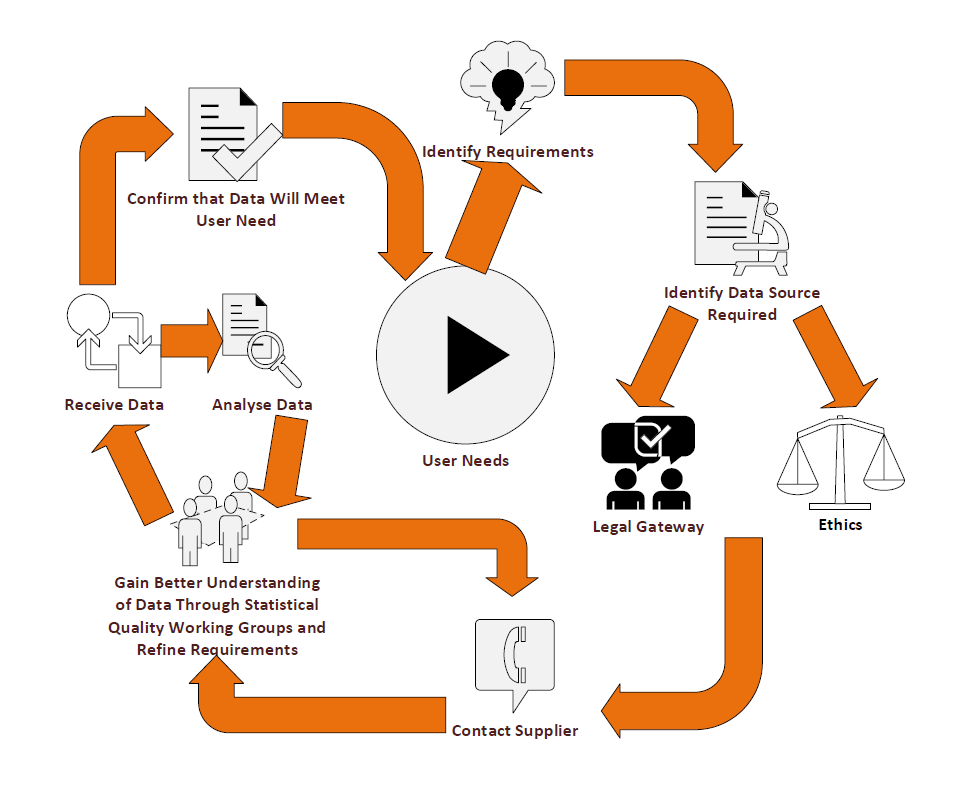
Source: Office for National Statistics
Notes:
- To view a larger version of Figure 2, please download the png.
Download this image Figure 2: Process for receiving new data sources
.png (84.9 kB)This year, we’ve worked with data suppliers to understand and specify our detailed data requirements for:
more detailed benefits and income data from the Department for Work and Pensions (DWP)
Real Time Information Pay As You Earn data and Self Assessment data from HM Revenue and Customs (HMRC)
health-related datasets from NHS Digital (including hospital episode statistics, mental health datasets and prescriptions)
The next step is the receipt and secure storage of these datasets.
This year, we’ve accessed new data sources from the Electoral Register, the All Education Dataset for England from the Department for Education (DfE) and an initial feasibility subset of Self Assessment data.
The Electoral Register contains a list of names and addresses, continuously updated through rolling monthly registration, for British, Irish, EU and Commonwealth citizens aged 16 years or over who have actively registered to vote. This potentially provides access to more current data for this sub-group of the population than other data sources.
The All Education Dataset for England is a longitudinal record-level education dataset that combines the National Pupil Database, and further education and higher education data. It includes a range of characteristics including qualifications. Research continues into the feasibility of using this dataset to provide “Qualifications Held” information.
We’ve also received administrative data from the Home Office. This extract contains data for non-EU migrants on study, work, family and other visas, which allows us to evaluate immigration and emigration patterns for non-EU citizens.
We’re also investigating:
additional variables in Higher Education Statistics Agency data such as nationality and country of birth
Tenancy Deposit Protection Scheme and record-level social rented data from the Ministry of Housing, Communities and Local Government and micro-level rental data from the Valuation Office Agency to produce new analyses on tenure
4.2 Ability to link
To create outputs with National Statistics status, we need to use the best available data linkage methods and have a robust understanding of the linkage quality. Until now, we’ve been linking data using pseudonymised identifiers. This restricts the methods that can be used to link data and makes it more difficult to measure accuracy in a robust and reliable way.
Working closely with our data suppliers, we’ve moved a number of datasets into our new secure data environment. This environment enables unencrypted identifiers to be used for data linkage, while maintaining security of the data as an ONS priority. This is the approach we referred to in last year’s assessment involving the separation of person identifiers (names, dates of birth and addresses) from information about their characteristics. Record linkage can then be undertaken to the highest standards, while still adhering to the principle of not holding identifiable information in one place for longer than required.
This will give us much more flexibility with our methods and allow improved linkage quality. We’ll be able to use statistical methods, including probabilistic linking, which are difficult to use confidently with pseudonymised identifiers. Also, it will make the assessment of the quality of the linkage easier and more comprehensive. Better data linkage will improve the accuracy of the outputs and can reduce bias in the results, since the demographics of people who can be difficult to match are often those of particular interest, for example, people who move house frequently.
Over the next year, we’ll make this approach our standard. We also intend to evaluate the accuracy of our current methods and further refine them. We currently assess this criterion as Amber, but expect it to move to Green/Amber next year as we fully implement the new approach.
4.3 Ability to meet information needs of decision-makers and users
4.3.1 Population statistics
The population statistics evaluation criteria include both providing mid-year population estimates and components of change. The mid-year population estimates are the stock or count of the population at a point in time. The components of change are the flows between each mid-year estimate (births, deaths, immigration, emigration and internal migration).
Our current assessment is that developments for both the mid-year population estimates and components of change are dependent on us having a population coverage survey live in the field and a methodology in place to use it to adjust our estimates. Given this breadth, we’ve expanded the criteria to demonstrate the progress across this work. Previously, we’ve focused on producing stock estimates from our Statistical Population Dataset (SPD) method. This year, we’ve expanded our research to include components of change, primarily migration. Our current assessment is summarised in Figure 3.
Figure 3: Population and migration estimates assessment
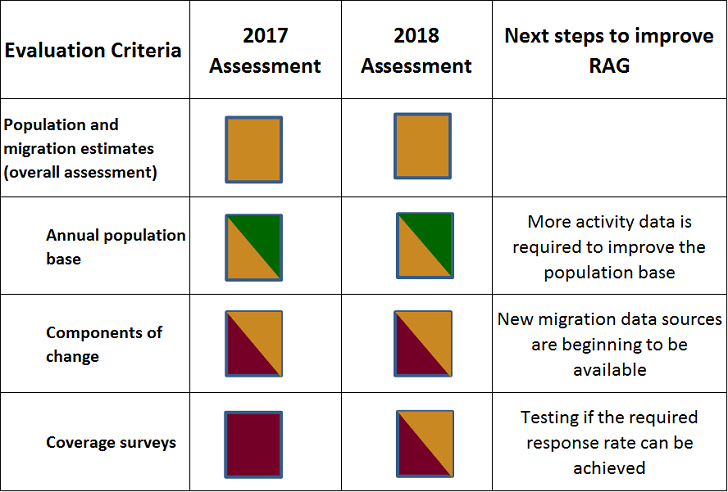
Notes:
- To view a larger version of Figure 3, please download the png.
Download this image Figure 3: Population and migration estimates assessment
.png (91.4 kB)Annual population base
For our population base, this year for the first time we’ve produced population estimates to Output Area level. This used our current Statistical Population Dataset (SPD) methodology approach. We assess these to be Green/Amber. To improve the quality of these estimates, we need a rules-based approach that makes best use of “activity”1 data and a survey, which enables us to measure and adjust for coverage issues.
More activity data are required to make this possible. In the next year, we expect to have access to activity data from Hospital Episode Statistics, Home Office administrative data and more detailed information from HM Revenue and Customs (HMRC) datasets.
Components of change
This year, we’ve started to investigate alternative approaches to measuring the size and structure of the population and the components of population change. Decision-makers and other users have told us it is important to understand more about the dynamics of population change. Rates of change are also an important element for producing population projections.
We’re currently looking at the feasibility of a flows-based approach to producing administrative-based population estimates. This approach is different to the current SPD method. It attempts to use the components of population change (flows) to update continuously the usually resident population rather than producing an independent stock estimate of the population each year.
We’ve assessed components of change to be Red/Amber. The status reflects that we have already good administrative data on births and deaths registrations, but that considerable challenges remain with identifying administrative data on migration.
We’re exploring other data sources that can help us identify different types of international migrants including long-term migrants who are usually resident in the UK. We’re interested to learn more about how migrants interact with public services and how combining data sources can tell us about their impact on education and health services and the economy.
This year, we’ve conducted research into internal migration estimates from SPDs.
The migration statistics transformation update published in May 2018 includes our plans to produce estimates of migration with administrative data at the core. In autumn this year, we plan to publish our findings from the feasibility research on utilising linked administrative data to provide international migration flows. Our research so far suggests that it is much more likely that we’ll be able to produce administrative data-based estimates of immigration than emigration.
Coverage surveys
This year, we’ve completed a small-scale test of a voluntary, mixed-mode Population Coverage Survey to assess response rates for different modes and demographics. The next steps of our research are to test if we can achieve the required response rate alongside testing different sampling strategies.
We’ve also produced a report on coverage-adjusted population estimates to compare two methods. This used an SPD adjusted with activity data in combination with a Population Coverage Survey (PCS) drawn from 2011 Census data to produce coverage-adjusted population estimates for 2011 by local authority. This work evaluated two methods – dual system estimation (DSE) and weighted class estimation (WCE). The results show that there is a higher prevalence of bias in the resulting estimates compared with variance. For most age-sex groups, DSE produced a positive bias (overestimation of the population) and WCE produced a negative bias (underestimation of the population). It is too early to be confident about which of these estimation methods would perform best. More sources of administrative data, including “activity” data, are required to improve the quality of these estimates.
We’re currently working with data suppliers including the Home Office, Department for Work and Pensions (DWP), NHS Digital and HMRC to acquire further activity data.
4.3.2 Household and family statistics
We’ve expanded the criteria into number, size and composition of households to highlight the progress that has been made in each area. Our current assessment is summarised in Figure 4.
Figure 4: Households and families estimates assessment
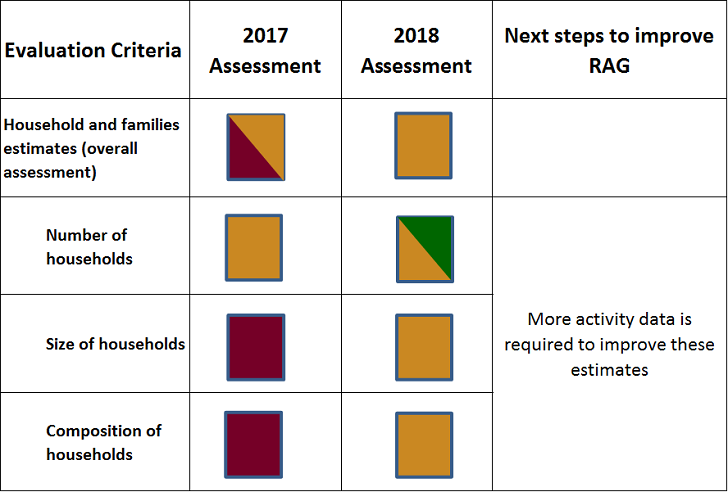
Source: Office for National Statistics
Notes:
- To view a larger version of Figure 4, please download the png.
Download this image Figure 4: Households and families estimates assessment
.png (66.3 kB)This year for the first time we have produced:
In July 2017, we held a workshop to discuss household statistics, exploring the opportunities and challenges brought about by using administrative data to define households. Over 60 users of household statistics attended from the public and private sectors. There were presentations on current household research including the work we’ve done on occupied addresses, discussions on uses of household statistics and an expert panel session. Discussions emphasised the need for continuous engagement with users in the development of administrative data-based household statistics and we held a further workshop in March 2018. There were no significant concerns expressed about the occupied address definition and producing statistics from administrative data on that basis.
We also produced a first set of Research Outputs on household composition, which showed more promise than expected, hence the move of this sub-criteria from Red to Amber.
Our publications demonstrate progress in each sub-category of this criteria. As a result, we’ve improved our assessment of the overall evaluation criteria from Red/Amber to Amber.
4.3.3 Population characteristics
In last year’s assessment, we published a diagram outlining the quality and availability of data for producing census topics. This year, we’ve updated that diagram to demonstrate our progress. See Figure 5. The composite quality measure shows how close the definition of the data is to what’s needed by decision-makers and users. It also shows whether there’s a known error in the data.
Purple diamonds represent the topics that we’ve published research on so far. This includes this year’s publications on labour market status and ethnicity.
There is a high user need for statistics on labour market status as they reveal areas of deprivation, inequality and labour market exclusion. This subsequently informs policy and economic decision-making at both the national and local level. We’ve published two Research Outputs this year that demonstrate progress on this topic area – labour market status estimates to local authority level and estimates of students in employment.
In May 2018, we held an event on “Transforming Labour Market Statistics by Integrating Survey and Non-Survey Data” to seek feedback on using administrative data for labour market statistics. This workshop included presenting our work on estimating labour market status from administrative data. At the workshop, there was an understanding of the challenges we face when using administrative data, however, there was also enthusiasm for the extra benefits administrative data could provide including the potential to estimate new areas of the labour market. We received feedback on our methodology and will use that to direct the next steps of our research.
We’ve also started some feasibility research into the use of machine-learning techniques to predict number of hours worked using survey responses. Number of hours worked is not available in any of the administrative data sources that we currently have access to. We plan to continue developing this research once we can link it to additional data sources.
Ethnicity is a high-priority characteristic as it is an important demographic component of populations. Ethnicity data are used in resource allocation and policy development, and by organisations to monitor and meet their statutory obligations under the Equality Act 2010. This year, we published new ethnicity estimates investigating a new approach combining administrative and survey data.
Using administrative and survey data showed promise for the ability to produce estimates of ethnicity by local authority. However, the survey data are less accurate for smaller ethnicities due to small sample sizes, which means the combined administrative and survey data estimates were also less accurate.
The blue diamonds in Figure 5 represent the census topics we’re currently working on and intend to publish research on by the end of 2019. This includes qualifications (now that we have access to data from the Department for Education (DfE) and nationality and country of birth (where we are investigating the use of census data alongside administrative data).
Figure 5: Quality and availability of data
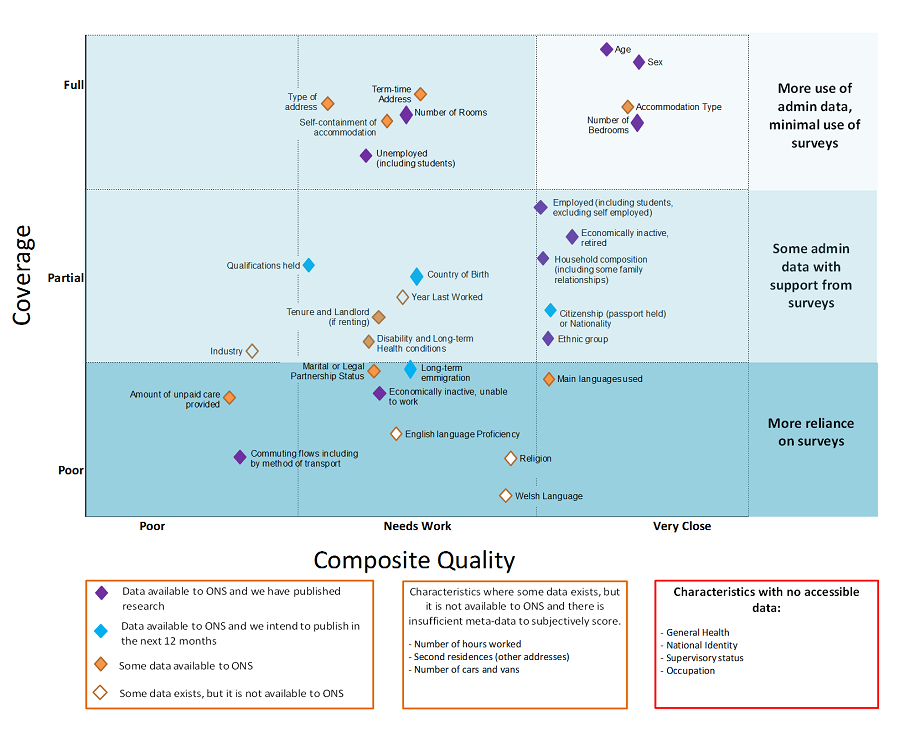
Source: Office for National Statistics
Notes:
Where multiple data sources exist that could be used to derive a characteristic, the assessment is based on the data that are currently available to ONS.
To view a larger version of Figure 5, please download the png.
Download this image Figure 5: Quality and availability of data
.png (201.0 kB)This year, we’ve also made progress in our income outputs research. Income is a variable that decision-makers and census users repeatedly ask to be included on the census, as it would provide an understanding of deprivation and affluence for small areas. However, it has never been included in UK censuses due to the negative impact on response and poor quality of resulting data. This year, we published progress towards the development of both individual and household income estimates down to Lower layer Super Output Area level.
We also published some research into new mothers’ income, improving our understanding of the behaviour of women around the time of childbirth. With additional data, this research could inform the gender pay gap and the provision of services supporting new mothers. This publication also demonstrated the feasibility of combining income information with other data sources to learn about population subgroups.
This year, we also published some analysis using mobile phone data to estimate commuting flows. There are a variety of user needs for these estimates including transport planning and monitoring, the planning of housing and related infrastructure, and labour market and economic planning.
In future years, we’ll continue to expand our work on population characteristics and will research additional areas not previously included on the census as described previously in our vision. This research will be driven by priority user needs.
4.3.4 Housing characteristics
This year, we published our assessment of estimating number of rooms and bedrooms using Valuation Office Agency (VOA) admin data. This research evaluated VOA data as an alternative to estimating the number of rooms and bedrooms on the 2021 Census. Lessons learnt about data quality are also applicable to an Administrative Data Census. We held a public consultation, inviting users to respond to this publication. We then published our response evaluating the Valuation Office Agency data.
In the consultation, respondents highlighted some quality concerns with the VOA data. These included the differences between VOA and 2011 Census for occupancy rating (bedrooms) and how frequently VOA records are updated.
We conducted further research to understand these issues in more detail and concluded that, at present, these quality concerns would indeed impact data use. Therefore, we intend to recommend asking number of bedrooms on the 2021 Census.
We’ll continue research into understanding the VOA data and how it can be used both to enhance the 2021 Census outputs and in an Administrative Data Census. This will include research to understand the quality of the number of rooms data and to consider how the property size and type variables could be used.
Notes for: Progress updates on each of the evaluation criteria
- “Activity” can be defined as an individual interacting with an administrative system, for example, for National Insurance or tax purposes, when claiming a benefit, attending hospital or updating information on government systems in some other way.
5. Acceptability to stakeholders
We’ve continued to consult with our users via a series of local authority engagement events and through the Administrative Data Census contact email. If you would like to get involved, please get in contact with us by email at Admin.Data.Census.Project@ons.gov.uk.
5.1 Engagement activities
This year, we’ve held two user events about household and labour market statistics. We’ll continue this approach focusing on other topics.
Alongside the close-working relationships on the 2021 Census, Office for National Statistics, National Records for Scotland and the Northern Ireland Statistics and Research Agency are also collaborating on the use of administrative data in population statistics and the 2021 Census.
Scotland is also considering future options for enhancing census and population statistics using administrative data and Northern Ireland is considering options for using administrative data to support the 2021 Census.
We continue to engage on the wider international stage with other national statistical institutes on a bilateral basis, through specially-convened working groups and the auspices of the UN. Many other countries are on a similar journey to us in recognising the opportunities in integrating data. Such collaboration is particularly useful in addressing the challenges of using administrative data, which are often common.
We also hosted an Integrated Data for Population Statistics Conference in July 2018 to update stakeholders on our progress and seek feedback.
Nôl i'r tabl cynnwys6. Value for money
At this time, there has been no formal assessment of value for money. In the previous Beyond 2011 Programme, we published a Summary of benefits of census information (PDF, 170KB). We’ll be reviewing the benefits in due course to inform the recommendation about the future of the census.
Nôl i'r tabl cynnwys7. Next steps
By the end of 2019, we will:
review the structure of this assessment and the assessment criteria given the wider opportunities from integrating data
consult on the shape of the new administrative data-based system on population and migration statistics (autumn 2018)
consult on needs in readiness to implement a new population and migration statistics system with administrative data at the core (by spring 2020)
publish our findings from the feasibility research on utilising linked administrative data to provide international migration flows (autumn 2018)
continue to hold user events on specific topics as appropriate
pursue the acquisition of:
- HM Revenue and Customs Self Assessment and further Pay as You Earn (PAYE) data
- further Home Office administrative data as necessary
- mental health, Hospital Episode Statistics and prescriptions data to explore potential for new analyses
apply our improved approach to data linkage in our new secure data processing environment whilst adhering to our legal, privacy, data protection and ethical obligations
produce Research Outputs on:
- educational qualifications (by end-2019)
- income distributions (using PAYE and benefits data) by ethnicity or nationality (late 2018 to early 2019)
- household composition by income (late 2018 to early 2019)
- income including Self Assessment data (subject to data access, by end-2019)
- labour market (subject to access to more detailed Pay As You Earn data, by end-2019)
- ethnicity for small areas (using integrated census and admin data, by end-2018)
- overcrowding estimates using Valuation Office Agency (VOA) data and research into use of floor space and property type (by end-2019)
